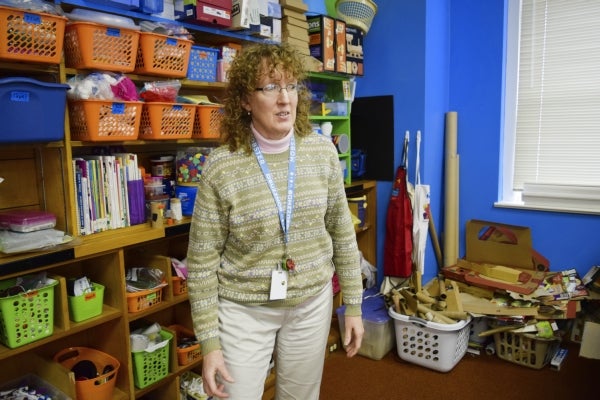Tinker Tailor: Media centers incorporate creative thinking
Published 12:00 am Thursday, February 11, 2016

- Litke, media coordinator at China Grove Elementary, shows off her makerspace. All of the materials were found, donated, received through grants or recycled. Rebecca Rider/Salisbury Post
CHINA GROVE — Beverly Litke shows off her makerspace — boxes full of cardboard tubes, shelves full of markers, papers, straws, cotton balls and other supplies. On the wall there’s a board for Legos and one for magnets, full of words.
“A makerspace can be anything,” Litke said, “and that’s the good thing.”
For the past week, Litke, media coordinator at China Grove Elementary, and other media coordinators across the district have been learning how to construct and implement makerspaces with TechTerra training.
TechTerra, a professional development camp that’s the brainchild of Susan Wells, teaches teachers and media coordinators practical ways to fuse STEM goals with creativity, communication, collaboration and critical thinking.
“Education is changing,” Litke said, “and the way people think about libraries, they don’t want it to change, but it is.”
The key is makerspaces – an area within the school or classroom set aside for creative construction, use of technology and projects.
“I don’t believe it’s a movement sweeping the nation,” Wells said, “I believe it’s really good pedagogy moving across the country.”
Makerspaces can be as high-tech as 3-D printers and programing or as simple as paper crafts and sewing projects.
“It can be as simple as cardboard and tape,” Litke said.
What’s important is that kids have an opportunity to show mastery of their learning.
“That’s kind of our goal — to be creators, not just consumers, of information,” Wells said.
Kids today are often passive observers when it comes to learning or interacting with the world around them. They watch videos online, or communicate using social media, but they don’t interact with the concepts behind it, and they’re not encouraged to create their own platforms, programs or tools. A makerspace can facilitate that interaction.
“Kids are doing something, not just consuming,” Wells said.
These creative spaces call out what Wells referred to as the “entrepreneurial spirit” of America.
“It’s not something that’s new,” she said.
Makerspaces are closely connected to the DIY movement, she said, and Litke agreed. The thinking outside the box creativity and “making do” goes back to the pioneer days, she said. Then, people didn’t have access to new tools, so they made them. If something broke, they had to fix it because replacing it wasn’t an option.
“You made it work,” she said.
These days, society has shifted towards a “throw-away” attitude, Litke said, but makerspaces bring back that creativity born from necessity.
Currently, Litke’s makerspace doesn’t have any technology. She’d like to incorporate it, but just doesn’t have the budget. So she’s pulled together what she could find. Her shelves and tables she pulled from around the school building when they were discarded by teachers, she’s added wheels to media center bookshelves to create a mobile space and all of the supplies used in her makerspace were donated. She said she hasn’t spent any money on it.
And other media center coordinators were enjoying learning to think creatively about space and activities.
“Everything she’s telling us is so practical,” Mary Sloop, media coordinator at Mt. Ulla Elementary said.
Wells worked as an educator and principal, and pulls her training and ideas from her own experience. Sloop said that made her suggestions very relatable and instantly applicable. TechTerra training also asks coordinators to plan their own space and think about sensible scheduling.
Sloop said she’s lucky to work with an excellent technology facilitator at Mt. Ulla, and dreams of filling her space with a 3-D printer and tools for coding and STEM projects.
“That’s the future,” she said, “They don’t need to wait to see it until they’re in high school.”
Litke has been running her own makerspace for a few years, but said the training helped her know she was on the right track.
“You can really justify what you’re doing . . . you’re not just out there doing something random,” she said.
Planning a makerspace is the easy part, Litke and Sloop said, the hard part is getting teachers to go along with it.
“They think they’re taking time out of their day,” Litke said, “but we’re trying to get them to see that this is part of their day.
If a student goes to a makerspace and is asked to make a model of the circulatory system, Litke said, they’re not just doing a craft. They have to pull on all of their knowledge about the circulatory system and think critically about how it works.
It’s an ownership of learning that some teachers may find scary, but Litke believes that if a child has completed a project in a makerspace enough to explain it to another student, they’ve demonstrated mastery of the subject.
And most importantly? It’s engaging, it’s a place for kids to think and stretch and grow and play.
“You get to play in this space,” Wells said, “everybody gets to.”
Techterra training will continue throughout the week, with each of the 35 Rowan-Salisbury media coordinators encouraged to create their own space, whether it’s a temporary pop-up or a permanent fixture in their libraries.


